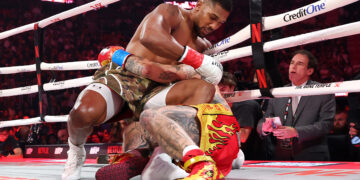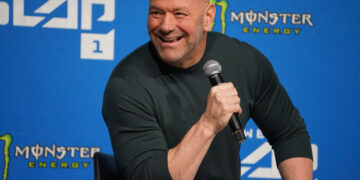
One of the exciting things about boxing is the cool ways fighters come up with to take their skills and conditioning to the highest level possible. Some of boxing’s greatest fighters lean toward more conventional approaches to training, while others incorporate activities that most people would deem odd.
How you train certainly affects how fast your skills and endurance improve, so let’s look at the training regimens of some of the most famous boxers who laced up a pair of gloves to see what we can learn from them.
Exploring The Training Regimens Of The Greatest Fighters In Boxing History
Ready to find out what the secret sauce that made fighters like Muhammad Ali so legendary? Let’s jump right into our list:
1) Muhammad Ali: The Greatest
Muhammad Ali didn’t become the greatest boxer to ever live by sitting on a couch all day. The GOAT was a workaholic who trained six days a week and only took Sundays off.
Here’s what Ali’s daily training routine looked like:
- Cardio: Ali would get up at 5:30 am and start his day with some stretches. Next came a six-mile run, followed by another round of stretching. Ali would then eat a breakfast that consisted of whole foods, water, and orange juice.
- Drills: Ali would then start a proper training session at the gym from about 12:30 to 3:30 pm. This session included a warmup of five three-minute rounds of shadow boxing with 30 seconds rest between each session. That was followed by six three-minute rounds of heavy bag work with 30 breaks between rounds.
- Sparring: Ali would then enter the ring and spar with training partners. Afterward, he would cool down by spending nine minutes on a speed bag, followed by a 20-minute jump rope session.
- Strength And Conditioning: Ali would use a one-minute shadow boxing session as a rest period after his skipping session before performing exercises that targeted his core muscles, such as reverse bicycle crunches. Another round of skipping followed the core work, this time focusing on lateral movements.
- Recovery: Ali would get a full body massage to help speed up the recovery process.
- Nutrition: Ali finished his day with a healthy dinner that mostly involved foods like beef, chicken, fruits, potatoes, green vegetables, and water or fruit juice.
2) Mike Tyson: The Most Dangerous Man On The Planet
Mike Tyson still holds the title of the youngest champion in boxing history, and he’s had one of the most controversial yet captivating careers. Discovered by legendary boxing coach Cus D’amato at 14, Tyson only needed six years of training to claim the WBC’s heavyweight title.
You’re probably wondering what Tyson was doing in the gym that allowed him to pick up the sport so quickly and become one of the greatest boxers to lace up a pair of gloves.
Here’s what his daily training routine looked like:
- Cardio: Tyson’s day typically started at 4 am and started with long stretching periods, followed by ten interval sprints and ten box jumps. He would run three to four miles, followed by a one-mile walk. He was typically done with all that by 5:30 am, and he would shower and return to bed. Tyson would be back up by around 10 am to enjoy a healthy breakfast that consisted of oatmeal and milk.
- Drills And Sparring: Tyson would be at the gym by 10 am, performing drills to improve his skills and sparring about ten rounds. Sparring was followed by lunch at 2 pm, which was often some pasta and steak or chicken with rice washed down with fruit juice. By three, Tyson was back in the gym performing more skill work and sparring sessions. This was followed by about an hour on an exercise bike.
- Strength And Conditioning: Tyson’s strength and conditioning started at around 5 pm, mainly consisting of calisthenics. He would perform 500 shrugs with a loaded barbell, 500 push-ups, 2,500 sit-ups, 2,000 bodyweight squats, and 800 dips. He would finish his workout sessions with about ten minutes of neck exercises, which explains why his neck is so thick.
- Nutrition: Tyson would be done with his workout by 7 pm, and it was time for dinner, which consisted of more steak or chicken with rice or pasta, washed down with some orange juice. He would work on a stationary bike for about 45 minutes after he was done with dinner. He would then go to bed at about 9:30 pm.
3) Floyd Mayweather Jr.: The Technical Genius
Unlike most of the boxers on our list, Floyd Mayweather isn’t a fan of structured workouts. Instead, Mayweather prefers a freestyle approach to his workouts, but don’t let that fool you into thinking he doesn’t put in work at the gym.
While unconventional, Mayweather, in his prime, spent more time than anyone else in his era perfecting his craft. Here’s what his training regimen looks like:
- Cardio: Mayweather often ends or starts his days with a five to six-mile morning run that starts around 3 am. Running is such a massive part of Mayweather’s lifestyle that his team often carries his running gear wherever he goes. It’s been said Mayweather would finish many nights of clubbing with one of his runs while his security team drove a convoy of cars behind him. His obsession with running probably has something to do with why his cardio never failed him during his career. Videos of Mayweather being winded in any of his fights don’t exist.
- Drills: When he’s done with his run, Mayweather often spends hours in the gym, hitting the heavy bags, speed bags, and pads. Unlike many other boxers who prefer to break up their skill drills into three-minute rounds, Mayweather spends as much as 20 minutes without any breaks on each drill station.
- Sparring: Mayweather spars often in the Mayweather boxing gym’s infamous “Doghouse.” Unlike most boxers who prefer to keep things simple, the Doghouse imitates the chaos of a real fight, with spectators in the gym encouraged to be as loud and obnoxious as possible. It can be a hostile environment for boxers with little experience fighting in front of crowds, but the culture there is one of the factors why Mayweather consistently performs at a high level in front of bright lights. Very few gyms have been able to imitate a real-fight environment for their fighters during sparring sessions.
- Strength And Conditioning: Mayweather typically does some strength and conditioning exercises during his training days. Most of his workouts consist of body weight exercises targeting the core. He also performs exercises to strengthen his neck.
- Recovery: Mayweather often warms up and begins his training sessions with shadowboxing and stretching. He’s also a fan of full-body massages and cryotherapy. He often holds light dumbbells in his hands when shadowboxing.
- Nutrition: Mayweather often acts like he doesn’t worry much about his diet, but that’s just a persona. Mayweather has a private chef who travels with him wherever he goes. His meals are usually balanced and rich in protein. Mayweather was just as disciplined with his diet as he was with his training, with minimal junk foods, no alcohol, and no recreational drugs.
4) Manny Pacquiao: The Pacman
Pacquiao’s work ethic, explosive power, and speed made him one of the most celebrated boxers of his generation. While he didn’t retire with a 50-0 record like his arch-rival Mayweather did, he remains the only boxer ever to win world titles in eight different divisions.
His approach to training was a unique blend of unconventional and traditional boxing activities.
The core of his training camps included:
- Cardio: Running up to eight miles to build his aerobic capacity and endurance. He also incorporated sprints into his runs.
- Drills: Pacquaio would then spend about an hour working on speed and heavy bags. He would also spend about an hour performing pad work with his trainer, Freddie Roach.
- Sparring: Pacquaio spars often during his training camps to refine techniques and adapt to challenges his next opponent presents.
- Strength And Conditioning: For strength and conditioning, Paquiao mixed up weight training exercises, like squats, deadlifts, and bench presses, with plyometric exercises.
- Recovery: Pacquaio performs stretches often to help with flexibility and recovery. He also uses other recovery tools like full-body massages.
- Nutrition: As far as his diet is concerned, Pacquiao is quite disciplined and sticks to a diet rich in proteins, complex carbohydrates, and healthy fats.
5) Canelo Alvarez: The Mexican Sensation
Canelo has secured titles in four divisions at this point in his career, and he’s been the biggest name in boxing since Mayweather and Pacquiao hung up their gloves.
Here’s what his training routine looks like:
- Cardio: Canelo spends about an hour running as much as five miles on training days to prepare his legs for 12-round fights.
- Strength And Conditioning: Alvarez performs full-body workouts thrice weekly during his camps. These sessions typically include weight training and high-intensity interval training. He often finishes his workout sessions with bodyweight exercises that target the core, like sit-ups. Canelo also performs lots of plyometric exercises like medicine ball slams and overhead throws.
- Boxing Drills: Canelo often works on his skills with heavy bags, focus mitts, and speed bags before entering the ring with his sparring partners.
- Sparring: Sparring is a crucial part of Canelo’s training regimen, and he aims to spar for about 30 minutes to an hour during training days.
- Nutrition And Recovery: Canelo uses stretching, massages, and taking days off to help speed up the recovery process.
6) Gennady Golovkin: The Kazakh Thunder
GGG has been one of the most dominant boxers in the current era, thanks to the explosive power in his hands and relentless fighting style. His trilogy against Canelo Alvarez gave boxing fans some of the best rounds they’ve seen all year.
Here’s what Golovkin’s training regimen looks like:
- Cardio: Like many boxers, GGG typically starts his day with a long run or sprints. Mondays, Wednesdays, and Fridays are for long runs, while he does sprints on Tuesdays and Thursdays to give his body a chance to recover. He also adds high-intensity interval training to his cardio workouts.
- Boxing Drills: GGG spends hours daily working on double-end bags, heavy bags, and focus mitts. These sessions help to refine his techniques in preparation for the challenges each opponent presents.
- Strength Training: Golovkin’s strength training routine consists of weightlifting exercises and calisthenics.
- Sparring: GGG likes sparring with training partners who can mimic the style of the opponent he’s scheduled to face next.
7) Vasyl Lomachenko: The Matrix
Lomachenko is one of the most decorated boxers in the modern era, and his footwork is always beautiful to observe.
Here’s how Lomachenko gets his body in tip-top condition for his fights:
- Cardio: Loma often wakes up at 5 am for an hour-long run before enjoying breakfast. He also adds activities like basketball, tennis, and swimming to help build up his endurance for his fights. One odd activity Lomachenko does for his cardio is holding his breath underwater for as long as possible. He believes the practice teaches his body how to deal with discomfort, which is something boxers often experience inside the ring.
- Strength And Conditioning: Lomachenko uses weightlifting exercises for the bulk of his workouts, with some bodyweight exercises.
- Drills: Loma spends about two hours during his training days performing boxing-focused work with his trainer.
- Mental Training: Lomachenko is a massive fan of using number grids to keep his brain sharp. Activities that stimulate the mind are believed to help a boxer’s reflexes.
- Sparring: Lomachenko often spars with multiple training partners to give him different looks.
- Nutrition: Loma wasn’t disciplined during his amateur days, but that didn’t stop him from winning multiple gold medals at the Olympics. He started taking his nutrition a lot more seriously after turning pro and sticks to a high-protein diet.
8) Sugar Ray Leonard: The Boxing Virtuoso
Known for his lightning-fast hands and graceful footwork, Sugar Ray Leonard was one of the most versatile boxers of his era, and his training regimen reflected his commitment to hone his skills and maintain peak physical condition.
- Cardio: Ray often ran as much as six miles on his training days and often added sprints to his runs as a form of high-intensity interval training. Leonard also spent lots of time skipping to improve his coordination, stamina, and footwork.
- Drills: Leonard typically spent a couple of hours daily working on speed bags, heavy bags, and pads.
- Sparring: Leonard believed in old-school attitudes toward sparring, and he typically sparred as often as he could.
- Strength And Conditioning: Leonard was a huge fan of circuit training during his training days, with each circuit typically consisting of calisthenics or boxing drills.
- Nutrition: Like most boxers, Leonard was disciplined with his diet, often sticking to lean meats, healthy fats, and limited carbs. He founded The Sugar Ray Leonard Foundation in 2009 to educate the public on proper nutrition to combat type 1 and 2 diabetes.
- Mental Training: Leonard was a huge fan of combat visualization and often went through all the possible scenarios in his mind before his fights.
- Recovery: Sugar Ray leaned toward ice baths and massages to help speed up recovery.
9) Naoya Inoue: The Monster
Inoue has emerged as one of the hardest hitters in boxing, and he’s already won world championships in four weight classes at only 31.
- Cardio: Inoue starts his day with about an hour of running, sprinting, or calisthenics. He also does a lot of sprinting up stairs or running while his coach pulls him back with a resistance band.
- Drills: Inoue spends about two hours daily working on his skills with pad work, heavy bags, speed bags, and shadowboxing.
- Sparring: Inoue spars more often than most boxers do today. He believes sparring often keeps him sharp during his fights and makes it easier for him to make adjustments.
- Strength And Conditioning: Inoue spends about two hours in the gym on training days, performing various weightlifting exercises for a full-body workout. He’s also a fan of unconventional workouts like hitting a tire with a sledgehammer.
- Recovery: Inoue is in tune with his body and has no problem taking a day off if he feels he needs rest. He also uses tools like massages to help with recovery.
10) Roberto Duran: Hands Of Stone
Duran was one of the most ferocious boxers ever to lace up his gloves, and many opponents succumbed to the explosive power in his hands.
Duran’s daily routine included:
- Cardio: Duran often started training days with a run that included going up hills and sprints to build his leg strength and endurance.
- Drills: Duran spent hours working on mitts, speed bags, and heavy bags to refine his combinations and defensive techniques.
- Strength And Conditioning: Duran enjoyed conventional weightlifting exercises like bench presses, deadlifts, and squats. He also performed calisthenic exercises like push-ups to build his muscle endurance.
- Sparring: Sparring was a considerable part of Duran’s training regimen, and he sparred as often as his body allowed.
Take What You Can From These Great Boxers And Create A Routine That Works For You
Wise people learn from the experience of others, so use these routines that worked for some of the biggest names in boxing history to create a training regimen that’s perfect for you.
You may also like:
3 Uppercuts Variations And 6 Ways To Use Them
The uppercut is arguably the most devastating punch used in boxing. Its upward trajectory often allows it to thread between an opponent’s guard and make contact with their chin. The punch can be equally destructive…
Good posture comes with its share of perks like helping you make a better first impression when you meet new people. Good posture gives you an air of authority and makes you appear taller than…
The Philly shell is a defensive stance in boxing that’s characterized by a boxer keeping their lead shoulder up and tucked in toward their chin while leaning away slightly from their opponent. The boxer’s lead…
Boxing has enjoyed a huge popularity boost in recent years thanks to factors like the many incredible champions and a growing number of influencers and celebrities willing to step inside a boxing ring. You probably…
The pull-back is a defensive technique that’s quite popular in boxing for various reasons, like how intuitive the technique becomes once you’ve drilled it enough times. The technique is typically most effective at outside distances,…
In the world of Boxing, Dmitry Bivol is the only man other than Floyd Mayweather who has handed boxing’s golden boy Saul “Canelo” Alvarez a loss inside the boxing ring. The two fought for the…
Kickboxing and Muay Thai training typically starts with learning the basics strikes like jabs, teeps, and roundhouse kicks. Once you’ve gotten the basic strikes used in Kickboxing down, it’s time to move on to basic…
So you’re finally done with school and on your way to your first job. Congrats! Starting a new office job can be exciting. It marks a new chapter in your professional life. However, adapting to…
Have you ever wondered why so many people get hooked on Brazilian Jiu-Jitsu? There are plenty of reasons why people who train Brazilian Jiu-Jitsu keep coming back. The traditional martial art continues to evolve and…
In Mixed Martial Arts, the 12-6 elbow is a downward elbow strike that follows a vertical path toward its target. Think of it as trying to draw a line between the 12 and 6 marks…
Posture is an essential aspect of BJJ and life. From a grappling perspective, it is a defense mechanism to prevent getting caught by threats on the mats and is an effective way to impose your…
Anatoly “Sladkiy” Malykhin is a special breed of fighter. The triple-champ from ONE Championship is the first MMA fighter to win titles in three different weight classes in a major MMA promotion, and the first…





![[WATCH] IND vs SA 2025: Umpire Rohan Pandit down in pain as Sanju Samson drive hits knee](https://babu88sports.com/wp-content/uploads/2025/12/watch-ind-vs-sa-2025-umpire-rohan-pandit-down-in-pain-as-sanju-samson-drive-hits-knee-360x180.jpg)



























